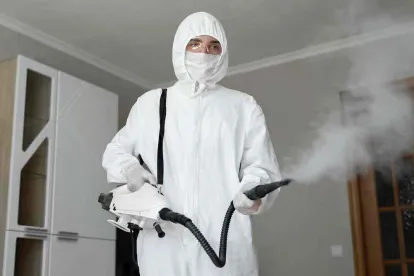On July 6, 2021, the New York State Department of Labor published multiple model documents related to the implementation of the New York HERO Act (the “Act”), which, as we previously reported, requires all employers in New York to adopt a prevention plan to protect against the spread of airborne infectious diseases in the workplace. Specifically, the state published: (1) The Airborne Infectious Disease Exposure Prevention Standard (the “Standard”); (2) a Model Airborne Infectious Disease Exposure Prevention Plan (the “Model Plan”); and (3) eleven industry-specific model plans for the prevention of airborne infectious disease.
Below is a summary of what employers need to know about the Standard, Model Plan, and the industry specific plans; as well as a list of steps for employers to take now that the standard and plans have been published.
Airborne Infectious Disease Exposure Prevention Standard: General Provisions
The Standard requires all employers with worksites in New York to establish a written airborne infectious disease exposure prevention plan. Notably, however, the Standard states that the prevention plan shall only apply when the New York State Commissioner of Health (the “Commissioner”) designates an airborne infectious agent or disease as a highly contagious communicable disease that presents a serious risk of harm to the public health. Therefore, while employers now have 30 days to adopt a plan, as of the date of this writing no designation has been made and plans are therefore not required to be implemented.
According to the Standard, once an airborne infectious disease is designated by the Commissioner as presenting a serious risk of harm to the public health, employers must:
-
Immediately review the worksite’s exposure prevention plan and update it, if necessary, to ensure that it incorporates current information, guidance, and requirements issued by federal, state, or local governments;
-
Finalize and promptly activate the worksite exposure prevention plan;
-
Conduct a “verbal review” of employer policies, employee rights under the Act, and the employer’s exposure prevention plan in a manner most suitable for the prevention of an airborne infectious disease – either in-person in a well-ventilated environment or via audio or video conference. Additional information about the verbal review process is included in the Model Plan and in the industry-specific model plans; and
-
Provide each employee with a copy of the prevention plan, post a copy of the plan in a visible and prominent location at the worksite, and ensure that a copy of the plan is accessible to employees during all work shifts.
While the designation remains in effect, employers must take certain steps to ensure that the plan is followed, including by: (1) assigning one or more supervisory employees to ensure adequate enforcement of the plan and other federal, state, or local guidance related to preventing the spread of the airborne infectious disease; (2) monitoring and maintaining exposure controls (as discussed further below); (3) monitoring for updated information and guidance from the Centers for Disease Control and Prevention (“CDC”) and New York State Department of Health (“NYSDOH”); and (4) updating the plan as necessary to comply with any new guidance.
Airborne Infectious Disease Exposure Prevention Standard: Exposure Controls
The Standard requires employers to select and obtain appropriate exposure controls based on the types and level of exposure risks employees have during activities performed at the worksite. Specifically, employers must include the following controls in their exposure prevention plan:
-
Health Screenings: Employers must conduct health screenings for the disease at the beginning of each workday in accordance with guidance issued by the NYSDOH or the CDC. Employers are also required to follow NYSDOH and CDC protocols regarding testing, isolation and quarantine before allowing employees to return to the worksite.
-
Face Coverings: Employers must select, provide at no cost, and require that employees wear appropriate face coverings whenever social distancing cannot be maintained in accordance with CDC and NYSDOH guidance.
-
Physical Distancing: Employers must implement physical distancing to keep employees at least six feet apart from others or as recommended by the CDC or NYSDOH.
-
Hand Hygiene Facilities: Employers must provide handwashing facilities; and when doing so is not practical and feasible, the employer must provide hand sanitizer with at least 60% alcohol that is effective against the infectious disease.
-
Cleaning and Disinfection: Employers must implement an appropriate plan for cleaning and disinfection based on recommendations by the CDC or NYSDOH; clean and disinfect surfaces known or believed to be contaminated; disinfect frequently touched surfaces throughout the workday; provide for the cleaning and disinfection of shared tools, equipment and workstations; and arrange for the cleaning and disinfection of common areas (such as bathrooms and break rooms) at least daily or as recommended by the CDC or NYSDOH.
In addition to providing face coverings, the Standard also required employers to provide and require that employees use personal protective equipment (“PPE”) as required or recommended by the NYSDOH. Employers must also provide training and information to employees regarding PPE and ensure the PPE is maintained in a sanitary condition and functioning properly.
Airborne Infectious Disease Exposure Prevention Standard: Anti-Retaliation
The Standard also addresses anti-retaliation requirements. Specifically, the Standard prohibits employers from taking any adverse action against an employee for: (1) exercising their rights under the Act or under the employer’s plan; (2) reporting violations of the Act or an employer’s plan when the employee reasonably believes, in good faith, that a violation occurred; (3) reporting an airborne infectious disease concern to their employer or a governmental entity, officer, or official; or (4) refusing to work when the employee reasonably believes, in good faith, that such work exposes workers to unreasonable risk from an airborne infectious disease due to working conditions that are inconsistent with the Standard or others laws, rules, policies, or order; provided, however, that the employee, another employee, or an employee representative notified the employer of the unsafe working condition and the employer failed to cure the conditions, or the employer had or should have had reason to know about the unsafe working conditions. To the extent that records exist between the employer and employee regarding a potential risk of exposure, such records must be maintained by the employer for at least two years after the conclusion of the designation of a high risk disease from the Commissioner.
Airborne Infectious Disease Exposure Prevention Plans
To comply with the Act’s written plan requirement, employers may either adopt the model plan applicable to their industry or establish an alternative plan that meets or exceeds the minimum requirements provided by the Standard. As of the date of publication, the state has issued eleven industry-specific templates for the following industries: agriculture, construction, delivery services, domestic workers, emergency response, food services, manufacturing and industry, personal services, private education, private transportation, and retail. All other sectors for which no industry-specific plan is available – including office-based workplaces – should refer to the Model Plan.
Notably, employers that adopt their own plan, rather than the Model Plan or an industry-specific plan, must adopt such plan pursuant to an agreement with the collective bargaining representative, and if there is no such representative, with the meaningful participation of employees. Any alternative plan must also be tailored and specific to the hazards in the specific industry and worksites of the employer.
In addition to providing additional detail about the minimum controls addressed in the Standard (see above), the Model Plan and industry-specific plans also address stay at home policies, respiratory etiquette, and special accommodations for individuals with added risk factors. The Model Plan also requires employers to determine if certain “advanced controls” are necessary, including: (1) the elimination of risky activities where adequate controls would not provide sufficient protection; (2) engineering controls (e.g., ventilation, disinfection, physical barriers); (3) administrative controls (e.g., training, signage, establishing pods or cohorts, etc.); and (4) the provision of additional PPE.
Next Steps for Employers
Now that the state has issued the Standard, Model Plan, and industry-specific plans, all employers with workplaces in New York State should take the following steps:
-
Adopt a Plan: All employers must adopt the model applicable to their industry or establish an alternative plan that meets or exceeds the minimum requirements provided by the Standard. This must be completed within 30 days from the date that the Standard was published – i.e., by August 5, 2021.
-
Provide the Plan to Employees: Employers must provide their plan to employees within 30 days of the adoption of the plan, within 15 days after reopening after a period of closure due to airborne infectious disease, and to new employees upon hire. The plan must be provided to employees in English and in the language identified by each employee as their primary language if a model standard is available in that language. The model standard is currently only available in English, but will be made available in Spanish in the coming days.
-
Post the Plan: The plan must be posted in a visible and prominent location in each worksite, with the exception of vehicles.
-
Update Your Handbook: For employers that provide employee handbooks, the prevention plan must be included.
Effective November 1, 2021, the Act also requires employers with at least ten employees to allow employees to establish and administer a joint labor-management workplace safety committee. Committees are authorized to, among other things, raise health and safety concerns, review safety policies, participate in certain site visits, and regularly schedule meetings during work hours. The Act directs the Department of Health to adopt rules and regulations related to the implementation of workplace safety committees, which have not yet been issued. We will continue to monitor and report on any further developments.






 />i
/>i

